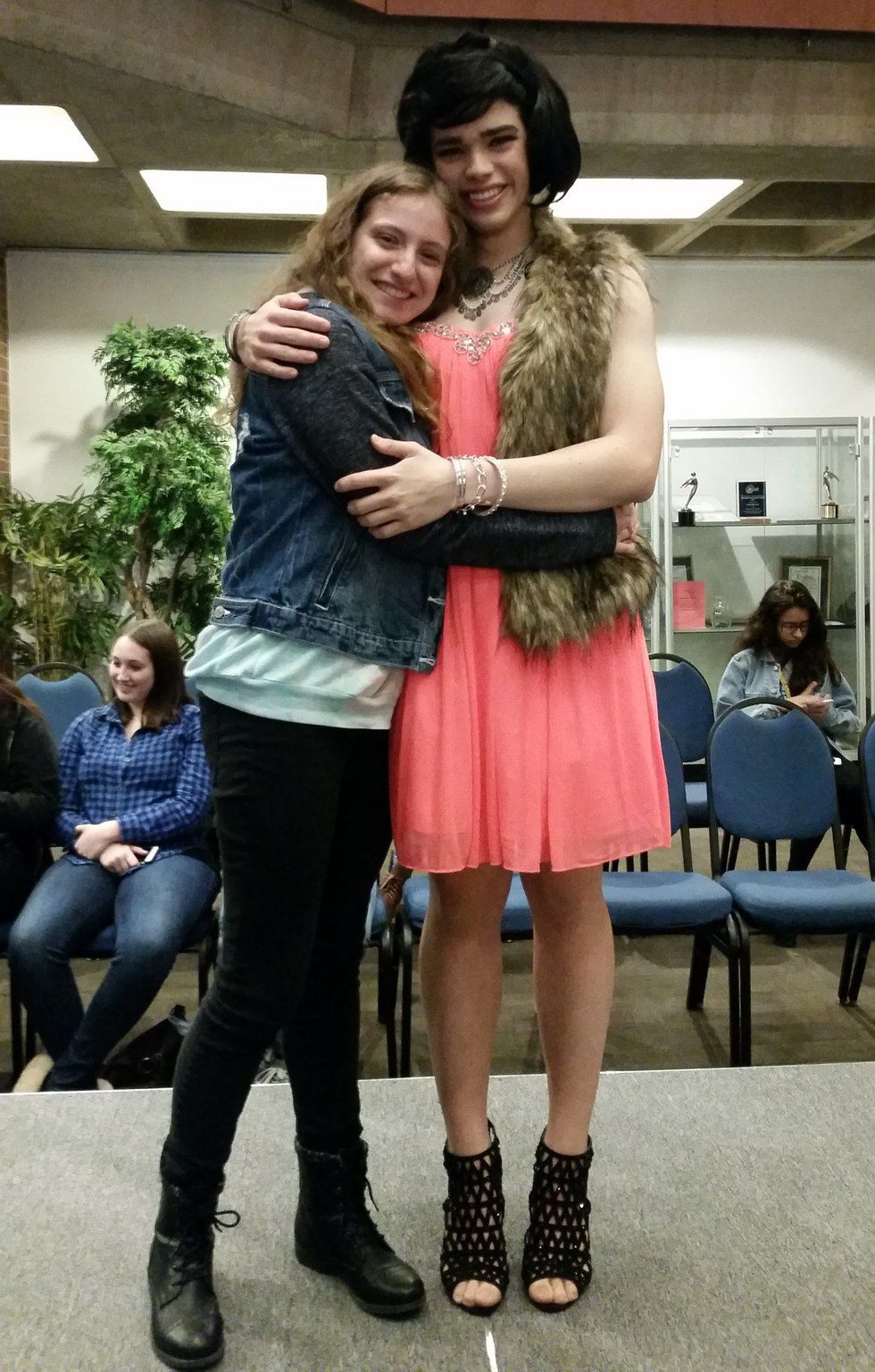All quotes in the article are taken from Will Darias.
In the beginning of the fall semester, I struck up a conversation with a person named Will in my class who recognized the logo on my shirt. After a few more interactions and an invitation to watch September’s blood moon together, we started dating. Six months later, Will and I are happily still in a relationship. Will is friendly, outgoing, and passionate. Will is also non-binary.
Non-binary people are part of a subset of the transgender community that exists for anyone who doesn’t identify within the gender binary of male and female. These people feel as if the strict expectations of these terms do not fit their experiences with gender, and, thus, identify outside of this binary. They create their own set of standards under which they feel more comfortable. Under the umbrella term of non-binary, or genderqueer, exist such labels as genderfluid, gender neutral, agender, androgynous, bigender, and pangender.
Will identifies as genderfluid, which means, according to them,
I am able to explore ‘femininity’ and ‘masculinity’ depending on my current conditions and who I am with at the moment. Different people bring out different aspects of me, none of which is the ‘truer’ version of myself – instead, these aspects (whether they’re stereotypically ‘feminine’ or ‘masculine’) constitute one fluid continuum that forms my identity.
While dating Will, I’ve learned a lot about the video games they like and about their home country of Cuba. But, mostly, I’ve learned a lot about life and the non-binary community through their open expression of their gender identity.
1. People are more loving than you think
National Coming Out Day is celebrated annually by the LGBT+ community on October 11. On this past Coming Out Day, Will made the brave decision to come out as genderfluid and wear a dress to class. As DMAB (designated male at birth) and generally presenting as male, this was a big step for Will. Surprisingly, most people on campus and in our classes, including our professor, were supportive. They received a lot of compliments and encouragement throughout the day. In addition, both of our parents were accepting and supportive of Will’s lifestyle after they came out.
2. Your own community is not always supportive
Despite doing what made Will comfortable in lieu of wearing a dress on Coming Out Day and participating in a drag show held on campus, they received backlash from some members of the transgender community on campus. Will was reprimanded for their choice of pronouns, their decision to not be constantly androgynous, and basically doing what made them comfortable in their gender identity. “If they had talked to me about it in a more comforting, peaceful way, I would have had an easier time listening to them. Instead, I felt attacked and hurt by the condescending way in which I felt I was being spoken to. Oftentimes, the way in which you say things matters much more than the content of what's being said.”
That being said, the community that you are a part of can also be an incredible source of support, advice, resources, and friends.
3. Clothing has no gender
Although I always fully supported anyone wearing any clothing, no matter what gender, I still considered clothes in the women’s section to be “women’s” and clothes in the men’s section to be “men’s.” However, this is not the case. Clothing is inherently genderless and you don’t have to identify with the gender of the section in which you are shopping. Gender expression is not necessarily tied to gender identity.
4. Andro and gynesexual
Will identifies as pansexual, which means that they are capable of being attracted to anyone, regardless of their gender identity. This made sense to me because wouldn’t someone who experiences the full spectrum of gender be attracted to anyone on said spectrum? However, I didn’t even consider the idea of non-binary people having other sexualities. When I asked Will about this, they told me about two sexualities that I was not aware of – androsexual and gynesexual.
Androsexuality is the attraction to the male anatomy. Gynesexuality is the attraction to the female anatomy. Both of these occur regardless of the person’s gender identity. Non-binary people can also identify with these.
5. Coming out is necessary for survival
Once you come out as non-binary, people change their expectations for you that are based on gender. If Will wants to paint their nails or wear makeup, no one will question them because of it because they know that they are not male and, therefore, don’t have to fulfill certain standards. It’s not the same as just being an effeminate male, because males are still held up to different expectations than non-binary people.
This section heading may sound drastic, but it’s no exaggeration. As of 2015, trans people run a much higher risk of suicide – 41 percent try to kill themselves at some point in their lives, compared with 4.6 percent of the general public. This can be mitigated simply by letting the trans people in your life know that you support and accept them.
6. Understanding genderfluidity better
Although I was a board member of my high school’s Gay Straight Alliance for four years, it was difficult for me, as a cisgender (identifying with the gender you were assigned with at birth) person to truly grasp the concept of genderfluidity, especially when there were no out members in the club. But Will patiently and clearly explained to me what it means to them in particular; and I feel better in our relationship and in life knowing the depth and complexity of this term.
7. Being yourself is the best way to live your life
People will vehemently try to reduce you to your sex and assumed gender expectations that come along with it. It's natural for humans to try to categorize things based on what they can see. And although human nature is hard to fight against, especially when non-binary is an unfamiliar term to current culture, it is an essential fight that necessitates “eliminating any sort of mask that you present to society…any kind of preservation of masculinity or femininity that doesn’t belong to your character and is only there because people are trying to piece together who you are by your gender.”
8. Appearances are important
“Passing” is a term used to describe when a person is able to physically appear as the gender they identify as. In this way, appearances are important when you are trying to pass. “It helps you express your gender identity. You are able to explore parts of yourself that may or may not be at odds with society. For example, wearing a dress or painting your nails can get taken away from you simply because of your gender. All these things that have to do with appearance help you explore. For me, it also lets people know that I am not cisgender and that is really important to me.”
9. Sometimes acceptance is enough
Mere acceptance from parents and other important people in your lives can sometimes be all you need. While active encouragement and support is more desirable, just being accepted by the people you care about is already a step in the right direction.
10. Labels aren’t for people to place other people into categories
You may be wondering: why all of the labels? Genderfluid and gender neutral are almost indistinguishable. Why do you need two words for it? Well, that’s the point. All of these labels exist because people who felt more comfortable with these descriptors created them in order to form their own set of standards that they feel are more fitting to their character. We don’t need to limit our terminology to a specific number of identities. We should, instead, expand it to how individuals see fit. Nonetheless, these labels are for you – not anyone else who tries to categorize you because it 'makes sense' to them.
11. Everyone experiences gender differently
While this is Will’s experience, everyone experiences gender and their identity differently. What genderfluidity means to Will may mean something different to someone else. And that’s okay. Identifying with a gender is all about being comfortable with yourself and how others perceive you.
12. Asking questions is OK
This one should be obvious. This article and my knowledge would never exist if I didn’t ask questions.
That being said, as long as you are respectful and courteous, trans people usually have no problem answering any questions that people may have.
In Will’s case, they encourage curiosity and trying to inform yourself further.
“Stay curious – in every sense of the word.”





















